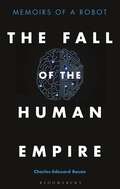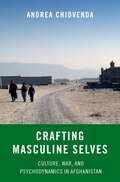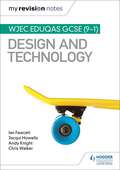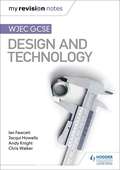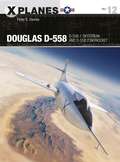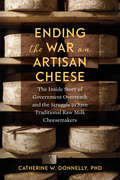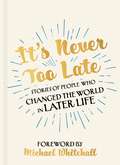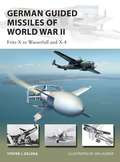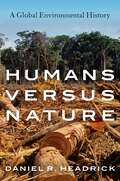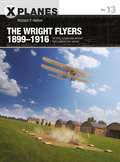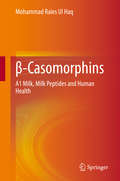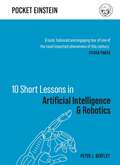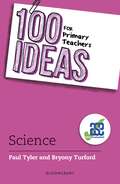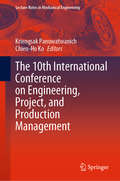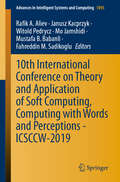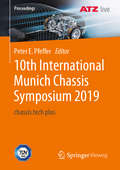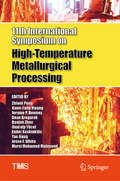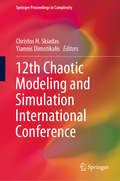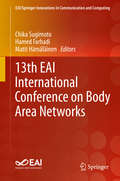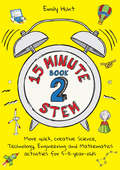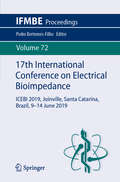- Table View
- List View
The Fall of the Human Empire: Memoirs of a Robot
by Charles-Edouard BouéeMachines that are smarter than people? A utopian dream of science-fiction novelists and Hollywood screenwriters perhaps, but one which technological progress is turning into reality.Two trends are coming together: exponential growth in the processing power of supercomputers, and new software which can copy the way neurons in the human brain work and give machines the ability to learn. Smart systems will soon be commonplace in homes, businesses, factories, administrations, hospitals and the armed forces. How autonomous will they be? How free to make decisions? What place will human beings still have in a world controlled by robots? After the atom bomb, is artificial intelligence the second lethal weapon capable of destroying mankind, its inventor?The Fall of the Human Empire traces the little-known history of artificial intelligence from the standpoint of a robot called Lucy. She – or it? – recounts her adventures and reveals the mysteries of her long journey with humans, and provides a thought-provoking storyline of what developments in A.I. may mean for both humans and robots.
History of Technology Volume 34 (History of Technology)
Despite having undergone major advances in recent years, the history of technology in Latin America is still an understudied topic. This is the first English-language volume to bring together a variety of critical perspectives on the history of technology in Latin America from the early-19th century through to the present day. This special issue, assembled by guest editor David Pretel, brings together a range of experts to explore a plethora of topics in Latin America's technological history. Papers include a study of rural telephony in in 20th-century Latin America; the rise of the 'Techno-class' in modern Brazil; an analysis of the rise and fall of three Caribbean commodities; the history of educational technology in Latin America, and science and technology in Cold War Chile.Special Issue: Technology in Latin American HistoryEdited by David Pretel (Colegio de Mexico, Mexico) and Helge Wendt (Max Plank Institute for the History of Science, Germany)
Crafting Masculine Selves: Culture, War, and Psychodynamics in Afghanistan
by Andrea ChiovendaAgainst the backdrop of four decades of continuous conflict in Afghanistan, the Pashtun male protagonists of this book carry out their daily effort to internally negotiate, adjust (if at all), and respond to the very strict cultural norms and rules of masculinity that their androcentric social environment enjoins on them. Yet, in a widespread context of war, displacement, relocation, and social violence, cultural expectations and stringent tenets on how to comport oneself as a "real man" have a profound impact on the psychological equilibrium and emotional dynamics of these individuals. This book is a close investigation into these private and at times contradictory aspects of subjectivity. Stemming from five years of research in a southeastern province of Afghanistan, it presents a long-term, psychodynamic engagement with a select group of male Pashtun individuals, which results in a multilayered dive not only into their inner lives, but also into the cultural and social environment in which they live and develop. Behind the screen of what often seems like outward conformity, Andrea Chiovenda is able to point to areas of strong inner conflict, ambivalence, and rebellion, which in turn will serve as the seeds for cultural and social change. These dynamics play out in a setting in which what was considered legitimate and justifiable violence on the battlefield has now spilled over into everyday life, even among non-combatants.
My Revision Notes: WJEC Eduqas GCSE (9-1) Design and Technology
by Ian Fawcett Jacqui Howells Andy Knight Chris WalkerExam board: EduqasLevel: GCSESubject: Design and TechnologyFirst teaching: September 2017First exams: Summer 2019Target success in WJEC Eduqas GCSE (9-1) Design and Technology with this proven formula for effective, structured revision. Key content coverage is combined with exam-style tasks and practical tips to create a revision guide that you can rely on to review, strengthen and test your knowledge.With My Revision Notes, you can:- plan and manage a successful revision programme using the topic-by-topic planner- consolidate subject knowledge by working through clear and focused content coverage- test understanding and identify areas for improvement with regular 'Now Test Yourself' tasks and answers- improve exam technique through practice questions, expert tips and examples of typical mistakes to avoid- get exam ready with extra quick quizzes and answers to the practice questions available online.
My Revision Notes: WJEC GCSE Design and Technology
by Ian Fawcett Jacqui Howells Andy Knight Chris WalkerExam board: WJECLevel: GCSESubject: Design and TechnologyFirst teaching: September 2017First exams: Summer 2019Target success in WJEC GCSE Design and Technology with this proven formula for effective, structured revision. Key content coverage for Engineering Design, Fashion and Textiles and Product Design is combined with exam-style tasks and practical tips to create a revision guide that you can rely on to review, strengthen and test your knowledge.With My Revision Notes you can:- plan and manage a successful revision programme using the topic-by-topic planner- consolidate subject knowledge by working through clear and focused content coverage- test understanding and identify areas for improvement with regular 'Now Test Yourself' tasks and answers- improve exam technique through practice questions, expert tips and examples of typical mistakes to avoid- get exam ready with extra quick quizzes and answers to the practice questions available online.
Douglas D-558: D-558-1 Skystreak and D-558-2 Skyrocket (X-Planes)
by Peter E. DaviesThe six Douglas D-558 research aircraft, built as two variants, were produced for a US Navy and NACA collaborative project to investigate flight in the high subsonic and supersonic regimes and to develop means of coping with the dangerous phenomena of compressibility and pitch-up which had caused many accidents to early jets. Wind tunnels could not provide the necessary data so pilots had to risk their safety in experimental aircraft which, for their time, achieved phenomenal performance. Both series of D-558 were well-designed, strong and efficient aircraft which enabled test pilots to tackle the unknown in comparative safety. Though delayed by their innovative but troublesome power-plants, and limited by the cost of their air-launched sorties, they went well beyond their original Mach 1 speed objective and continued to generate information that provided design solutions for a whole generation of supersonic combat aircraft. Although the final stage of the D-55 programme, the USN's 'militarized' D-558-3, never happened, the Navy was able to apply the lessons of the programme to its much more practical combat types such as the F8U Crusader and F3H Demon. Supported by full-colour artwork including three-view plates of the two D-558 models and a technical view of the D-2 cockpit, this authoritative text offers a comprehensive guide to the record-breaking Navy research craft.
Ending the War on Artisan Cheese: The Inside Story of Government Overreach and the Struggle to Save Traditional Raw Milk Cheesemakers
by Doctor Catherine DonnellyA prominent food scientist defends the use of raw milk in traditional artisan cheesemaking. Raw milk cheese—cheese made from unpasteurized milk—is an expansive category that includes some of Europe’s most beloved traditional styles: Parmigiano Reggiano, Gruyère, and Comté, to name a few. In the United States, raw milk cheese forms the backbone of the resurgent artisan cheese industry, as consumers demand local, traditionally produced, and high-quality foods. Internationally award-winning artisan cheeses like Bayley Hazen Blue (Jasper Hill, VT) would have been unimaginable just forty years ago when American cheese meant Kraft Singles. Unfortunately the artisan cheese industry faces an existential regulatory threat. Over the past thirty years the US Food and Drug Administration (FDA) has edged toward an outright ban on raw milk cheeses. Their assault on traditional cheesemaking goes beyond a debate about raw milk safety; the FDA has also attempted to ban the use of wooden boards, the use of ash in cheese ripening, and has set stringent microbiological criteria that many artisan cheeses cannot meet. The David versus Goliath existence of small producers fighting crushing regulations is true in parts of Europe as well, where beloved creameries are going belly-up or being bought out because they can’t comply with EU health ordinances. Centuries-old cheese styles like Fourme d’Ambert and Cantal are nearing extinction, leading Prince Charles to decry the “bacteriological correctness” of European regulators. The dirty secret is that Listeria and other bacterial outbreaks occur in pasteurized cheeses more often than in raw milk cheeses, and traditional processes like ash-ripening have been proven safe. In Ending the War on Artisan Cheese, Dr. Catherine Donnelly forcefully defends traditional cheesemaking, while exposing government actions in the United States and abroad designed to take away food choice under the false guise of food safety. This book is fundamentally about where and how our food is produced, the values we place on methods of food production, and how the roles of tradition, heritage, and quality often conflict with advertising, politics, and profits in influencing our food choices.
It's Never Too Late: Stories of People Who Changed the World in Later Life – Foreword by Michael Whitehall
by Chester MorganfieldThe best is yet to come; stories of the inspiring, inventive, and brave things people have achieved in later life. With a foreword by Michael Whitehall, late bloomer par excellence.With life comes perspective, wisdom, judgement and depth. You are as likely to change the world after middle age as you were before it - and perhaps more likely to change it for the better. From the well known to the unsung, each entry tells the story of how older age was no barrier to impressive feats of intellect, creativity and daring. Ranging from Alexander Fleming, Stan Lee and Baroness Trumpington, to Whina Cooper and the bestselling novelist Mary Wesley who didn't write her first novel until she was 71, and William Ivy Baldwin who tightrope walked across a canyon at 82. Here is a celebration of the amazing things we humans have shown to be possible in later life. A gift book for late bloomers, baby boomers, and beyond; and an inspiring picture of the possibilities and potential that older age holds.
German Guided Missiles of World War II: Fritz-X to Wasserfall and X4 (New Vanguard)
by Steven J. ZalogaAlthough not as well-known as the V-1 buzz bomb and the V-2 missile, the first German missiles to see combat were anti-ship missiles, the Henschel Hs.293 guided missile and the Fritz-X guided bomb. These began to see extensive combat in the Mediterranean in 1943. In their most famous use, the Italian battleship Roma was sunk by a Fritz-X attack in September 1943 when Italy attempted to switch sides. The serious threat posed by these missiles led to a vigorous but little known 'Wizard War' by the Allies to develop electronic counter-measures, the first effort of its kind. Besides the anti-ship missiles, the other major category of German missiles were the air-defence missiles. Germany suffered extremely heavy losses from Allied strategic bombing attacks, and German fighter and flak defences proved increasingly unsuccessful. As a result, the Luftwaffe began an extensive programme to deploy several families of new air defence missiles to counter the bomber threat, including the Wasserfall, Schmetterling, and others. This book traces the origins of these missile programmes and examines their development and use in combat. With full-colour illustrations and detailed explorations of the stories behind the missiles, this study offers a comprehensive overview of German guided missiles in the World War II era.
Press Start: Using gamification to power-up your marketing
by Daniel Griffin Albert van MeerDo you know someone obsessed with a mobile game like Candy Crush? Have you ever felt a rush when you completed a task… and perhaps another when you crossed it off your to-do list? Or maybe you have that one running-obsessed friend who has to log everything on their fitness app?The fact is, these obsessions and 'highs' affect all of us, and they can be powerful drivers in terms of how we behave. In an increasingly commoditized world, marketers are always looking for new ways to influence or motivate us to be better engaged with their products, services, and brands. This is marketing gamification: the practice of taking the motivational elements of games (like challenges, achievements and teams) and applying them intelligently in real-life situations to improve engagement and performance. With many success stories from the likes of LinkedIn, Delta Airlines, Starbucks, and Duolingo, marketing gamification is already a well-established practice, but many businesses are wary of jumping in without a guide - especially as there have been so many high-profile failures.Written specifically for marketing professionals, Press Start explores the benefits and uses of gamification, and ties together motivational psychology and case studies with popular game mechanics and design principles. More importantly, the book will provide readers with a step-by-step guide for successfully designing their own marketing gamification solutions.
Humans versus Nature: A Global Environmental History
by Daniel R. HeadrickSince the appearance of Homo sapiens on the planet hundreds of thousands of years ago, human beings have sought to exploit their environments, extracting as many resources as their technological ingenuity has allowed. As technologies have advanced in recent centuries, that impulse has remained largely unchecked, exponentially accelerating the human impact on the environment. Humans versus Nature tells a history of the global environment from the Stone Age to the present, emphasizing the adversarial relationship between the human and natural worlds. Nature is cast as an active protagonist, rather than a mere backdrop or victim of human malfeasance. Daniel R. Headrick shows how environmental changes--epidemics, climate shocks, and volcanic eruptions--have molded human societies and cultures, sometimes overwhelming them. At the same time, he traces the history of anthropogenic changes in the environment--species extinctions, global warming, deforestation, and resource depletion--back to the age of hunters and gatherers and the first farmers and herders. He shows how human interventions such as irrigation systems, over-fishing, and the Industrial Revolution have in turn harmed the very societies that initiated them. Throughout, Headrick examines how human-driven environmental changes are interwoven with larger global systems, dramatically reshaping the complex relationship between people and the natural world. In doing so, he roots the current environmental crisis in the deep past.
The Wright Flyers 1899–1916: The kites, gliders, and aircraft that launched the “Air Age” (X-Planes)
by Richard P. HallionOrville and Wilbur Wright, two bicycle-making brothers from Dayton, Ohio, secured their place as the most famous names in aviation history when, on December 17, 1903, they made the first powered, controlled, and sustained heavier-than-air flight. But their success over the cold and windswept Carolina dunes that day has overshadowed their many other accomplishments before and after that historic flight. The Wrights' progression from theory to analysis to ground-testing components and wing shapes, and then to flight-testing kites, gliders, and their first powered aeroplane, marked the world's first successful 'X-Plane' research and development programme. They established a template all subsequent aircraft have followed, one still relevant in the era of hypersonic flight and drone research.This book traces the Wright Brothers' story, from their first success on that cold December day throughout their glory years to their eventual eclipse by other aviators. It explores in detail the process that lead them to their pioneering craft and their many subsequent achievements over the following years, and highlights their enduring importance in the age of modern flight.
The History of Tanks
by Simon FortyThe tank was born to break the deadlock of World War I’s Western Front, where trench-based defence in depth, barbed wire, machine guns and artillery, led to immense loss of life. Initially dogged by mechanical unreliability and early misuse, post-First World War development of technology and tactics saw the Germans open World War II with the devastating Blitzkrieg in which armoured divisions led the way. Tanks dominated the battlefields’ of World War II and have continued to develop, reaching their peak with the so called “Main battle tanks”: of the biggest military-industrial complexes: the US Abrams, German Leopard, British Challenger, Israeli Merkava and Russian T90.Today, in a world of asymmetric warfare, tanks may dominate the battlefield, but infantry rocket weapons and anti-tank helicopters have evened things up and ensure that tanks must develop further to meet changing threats. In The History of Tanks about the changing face of tank warfare through the 50 most important, iconic vehicles from 1914 to today.
β-Casomorphins: A1 Milk, Milk Peptides and Human Health
by Mohammad Raies Ul HaqThis book compiles the latest research on the A1 and A2 forms of cow milk, and attempts to show a correlation between the type of cow milk consumption and reported incidence of certain diseases (type 1 diabetes mellitus, cardiovascular diseases, sudden infant death syndrome and neurological disorders). Cow milk generally contains two types of β-casein, A1 or A2. The book describes the A1/A2 hypothesis, its foundation and the genetics behind it. It discusses the two forms of milk and why one is considered more harmful than the other. Seeking to provide a balanced view of the milk types, the book’s initial chapters highlight the structure, function and physiological activity of β-casomorphins. Subsequent sections describe the health concerns associated with A1 milk, and the various case studies and research surrounding it. In turn, the arguments against the hypothesis put forward by EFSA, American Nutritionists and Truswell are also highlighted. The book does not make any recommendations for dairy consumers; rather, it is a collection of essential data both in favour and against the hypothesis. Further mechanistic studies involving well-designed animal and human trials at the cellular, molecular, biochemical and immunological levels will be needed in order to draw sound conclusions. Overall, the hypothesis is fascinating, and possibly significant. However, verified and authenticated research with reproducible results is needed to make final consumer recommendations. This timely book offers a valuable resource for researchers and students of dairy science, as well as industry experts.
10 Short Lessons in Artificial Intelligence and Robotics
by Dr Peter J. Bentley'A lucid, balanced and engaging tour of one of the most important phenomena of this century.' – Steven PinkerFrom the face recognition on your smartphone to the management of our global economy, you cannot live in the modern world without interacting with, or being impacted by, artificial intelligence and robots. But how did this happen? And what does it mean for our lives now and in the future? Is it helping to change our world for the better or creating new problems? 10 Short Lessons in Artificial Intelligence & Robotics examines these key questions and more in this essential guide to the twenty-first century’s most powerful technology.About the series: The Pocket Einstein series is a collection of essential pocket-sized guides for anyone looking to understand a little more about some of the most relevant science that affects us all in the twenty-first century. Broken down into ten simple lessons and written by leading experts in their field, discover the ten most important takeaways from those areas of science we should all know more about.
100 Ideas for Primary Teachers: Science (100 Ideas for Teachers)
by Paul Tyler Bryony Turford100 Ideas for Primary Teachers: Science is filled with exciting yet achievable ideas to engage pupils in all areas of the National Curriculum for science. With a whole host of ideas for activities, experiments, assessment and increasing parental engagement, this book will help primary teachers develop pupils' knowledge and shape their attitudes towards learning science.Paul Tyler and Bryony Turford cover the key areas of biology, chemistry and physics, providing specific teaching strategies and resources to demonstrate scientific concepts and link science to other curriculum subjects, particularly maths and English. Activities range from exploring gravity by building a marble run to simulating the human digestive system! Also included are ideas to build pupils' science capital so they feel inspired and invested in the sciences in the long term. Each idea, activity and experiment is ready to use and easy to follow for all primary teachers, regardless of their level of confidence in the sciences.
101 Inclusive and SEN Art, Design Technology and Music Lessons: Fun Activities and Lesson Plans for Children Aged 3 – 11
by Kate Bradley Claire BrewerCreate an inclusive classroom for all with these fun and accessible activities for Art, Design Technology and Music lessons. Each lesson is tailored for children working below National Curriculum levels and includes a learning objective, the resources needed, the main activity, a plenary and a consolidation activity to help support children's understanding. Activities such as 'Peg Painting' and 'Build my Car' build visual, auditory, social communication and fine motor skills and support self-esteem and mental wellbeing.The 101 creative activities in this book aim to support the ever-increasing demands on teachers to meet the needs of the growing number of SEN learners in mainstream settings. It also offers practical lesson plans that have been specifically designed to promote fine and gross motor skills and utilise lots of visual stimulus.
The 10th International Conference on Engineering, Project, and Production Management (Lecture Notes in Mechanical Engineering)
by Kriengsak Panuwatwanich Chien-Ho KoThis book gathers the proceedings of the EPPM 2019 conference, and highlights innovative work by researchers and practitioners active in various industries around the globe. Recent advances in science and technology have made it possible to seamlessly connect and integrate various elements of engineering systems, and opened the door for innovations that have transformed how we live and work. While these developments have yielded enhanced efficiency and numerous improvements in our current practices, the problems caused by the increased complexity of these integrated systems can be extremely difficult. Accordingly, solving these problems involves applying cross-disciplinary expertise to address the heterogeneity of the various elements inherent in the system. These proceedings address four main themes: (I) Smart and Sustainable Construction, (II) Advances in Project Management Practices, (III) Toward Safety and Productivity Improvement, and (IV) Smart Manufacturing, Design, and Logistics. As such, they will be of interest to and valuable to researchers and practitioners in a range of industries seeking an update on the translational fields of engineering, project, and production management.
10th International Conference on Theory and Application of Soft Computing, Computing with Words and Perceptions - ICSCCW-2019 (Advances in Intelligent Systems and Computing #1095)
by Rafik A. Aliev Janusz Kacprzyk Witold Pedrycz Mo Jamshidi Mustafa B. Babanli Fahreddin M. SadikogluThis book presents the proceedings of the 10th Conference on Theory and Applications of Soft Computing, Computing with Words and Perceptions, ICSCCW 2019, held in Prague, Czech Republic, on August 27–28, 2019. It includes contributions from diverse areas of soft computing and computing with words, such as uncertain computation, decision-making under imperfect information, neuro-fuzzy approaches, deep learning, natural language processing, and others. The topics of the papers include theory and applications of soft computing, information granulation, computing with words, computing with perceptions, image processing with soft computing, probabilistic reasoning, intelligent control, machine learning, fuzzy logic in data analytics and data mining, evolutionary computing, chaotic systems, soft computing in business, economics and finance, fuzzy logic and soft computing in earth sciences, fuzzy logic and soft computing in engineering, fuzzy logic and soft computing in material sciences, soft computing in medicine, biomedical engineering, and pharmaceutical sciences. Showcasing new ideas in the field of theories of soft computing and computing with words and their applications in economics, business, industry, education, medicine, earth sciences, and other fields, it promotes the development and implementation of these paradigms in various real-world contexts. This book is a useful guide for academics, practitioners and graduates.
10th International Munich Chassis Symposium 2019: chassis.tech plus (Proceedings)
The increasing automation of driving functions and the electrification of powertrains present new challenges for the chassis with regard to complexity, redundancy, data security,and installation space. At the same time, the mobility of the future will also require entirely new vehicle concepts, particularly in urban areas. The intelligent chassis must be connected, electrified, and automated in order to be best prepared for this future.
11th International Symposium on High-Temperature Metallurgical Processing (The Minerals, Metals & Materials Series)
by Zhiwei Peng Jiann-Yang Hwang Jerome P. Downey Dean Gregurek Baojun Zhao Onuralp Yücel Ender Keskinkilic Tao Jiang Jesse F. White Morsi Mohamed MahmoudIn recent years, global metallurgical industries have experienced fast and prosperous growth. High-temperature metallurgical technology is the backbone to support the technical, environmental, and economical needs for this growth. This collection features contributions covering the advancements and developments of new high-temperature metallurgical technologies and their applications to the areas of processing of minerals; extraction of metals; preparation of refractory and ceramic materials; sintering and synthesis of fine particles; treatment and recycling of slag and wastes; and saving of energy and protection of environment. The volume will have a broad impact on the academics and professionals serving the metallurgical industries around the world.
12th Chaotic Modeling and Simulation International Conference (Springer Proceedings in Complexity)
by Christos H. Skiadas Yiannis DimotikalisGathering the proceedings of the 12th CHAOS2019 International Conference, this book highlights recent developments in nonlinear, dynamical and complex systems. The conference was intended to provide an essential forum for Scientists and Engineers to exchange ideas, methods, and techniques in the field of Nonlinear Dynamics, Chaos, Fractals and their applications in General Science and the Engineering Sciences. The respective chapters address key methods, empirical data and computer techniques, as well as major theoretical advances in the applied nonlinear field. Beyond showcasing the state of the art, the book will help academic and industrial researchers alike apply chaotic theory in their studies.
13th EAI International Conference on Body Area Networks (EAI/Springer Innovations in Communication and Computing)
by Chika Sugimoto Hamed Farhadi Matti HämäläinenThe papers in this proceeding discuss current and future trends in wearable communications and personal health management through the use of wireless body area networks (WBAN). The authors posit new technologies that can provide trustworthy communications mechanisms from the user to medical health databases. The authors discuss not only on-body devices, but also technologies providing information in-body. Also discussed are dependable communications combined with accurate localization and behavior analysis, which will benefit WBAN technology and make the healthcare processes more effective. The papers were presented at the 13th EAI International Conference on Body Area Networks (BODYNETS 2018), Oulu, Finland, 02-03 October 2018.
15-Minute STEM Book 2: More quick, creative science, technology, engineering and mathematics activities for 5-11-year-olds
by Emily HuntEmily Hunt's 15-Minute STEM Book 2: More quick, creative science, technology, engineering and mathematics activities for 5-11-year-olds offers a stimulating selection of easy-to-resource STEM activities designed to engage and inspire young learners. Like most teachers and parents, you probably recognise STEM as being an important priority area for modern education. You may, however, be wondering: What does STEM education look like for young learners? How do I get children excited about STEM education? How can children learn STEM skills in just 15 minutes? What equipment do I need to teach STEM activities? Enter 15-minute STEM with the answers! Full of engaging and practical ideas, this innovative resource builds on the success of Emily's 15-Minute STEM (ISBN 978-178583335-9) and reassures teachers and parents that they don't need to be experts to deliver high-quality STEM education. Each of the 40 activities includes step-by-step instructions, takes just 15 minutes to complete and can be resourced from everyday materials found in the classroom or at home. This means that, with minimal preparation, teachers and parents can slot these cross-curricular activities into an otherwise busy day - simultaneously broadening children's learning and piquing their curiosity about the world around them. Accompanying instructions are phrased in a way that encourages the children to lead the learning and exploration, and opportunities for further investigation are provided in order to broaden the learning focus. Hand-drawn illustrations and full colour photographs are also included alongside each activity to give an idea of what the end results might look like. The activities make connections to real-world scenarios and have been linked to conceptually similar STEM-related careers - all of which are individually profiled in a glossary at the back of the book. The practical, problem-solving element of each activity offers a great way for children to develop important soft skills such as creativity, critical thinking and spatial awareness. Suitable for both educators and parents of young children.
17th International Conference on Electrical Bioimpedance: ICEBI 2019, Joinville, Santa Catarina, Brazil, 9-14 June 2019 (IFMBE Proceedings #72)
by Pedro Bertemes-FilhoThis book gathers the proceedings of the 17th International Conference on Electrical Bioimpedance (ICEBI 2019), held on June 9-14, in Joinville, Santa Catarina, Brazil. The chapters cover the latest knowledge and developments concerning: sensors and instrumentation to measure bioimpendance, bioimpedance imaging techniques, theory and modeling and bioimpendance, as well as cutting-edge clinical applications of bioimpendance. All in all, this book provides graduate students and researchers with an extensive and timely snapshot of current research and challenges in the field of electrical bioimpendance, and a source of inspiration for future research and cross-disciplinary collaborations.
